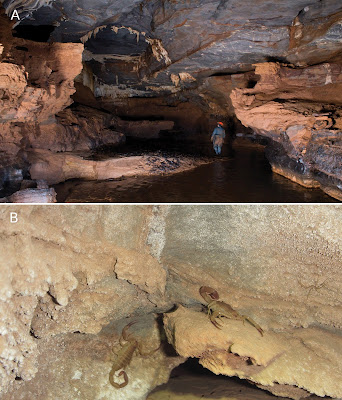 |
| Tityus (Tityus) spelaeus Moreno-González, Pinto-da-Rocha & Gallão, 2021 |
Abstract
We present a molecular phylogenetic analysis including a survey for overlooked phenotypic characters. Based on both analysis and characters a new cave-dwelling species is described: Tityus (Tityus) spelaeus sp. nov. from the Russão II cave, Posse, state of Goiás, Central Brazil. Characters such as the glandular regions of the female pectinal basal piece and basal middle lamellae of pectines, and the distribution of the ventral setae of telotarsi I–IV proved to be useful to constructing the taxonomy of species and species groups of Tityus. The new species is a member of the Tityus trivittatus species-group of Tityus (Tityus) and can be readily recognized by the immaculate coloration pattern and the more developed glandular region on the female pectinal basal piece. In addition, we provide a discussion of the phylogenetic relationships observed within Tityus, on the relevance of the new phenotypic characters to the modern taxonomy of the genus Tityus, and to the records of Brazilian cave scorpions.
Keywords: Cave, Neotropics, scorpion, South America, state of Goiás
Family Buthidae C. L. Koch, 1837
Genus Tityus C. L. Koch, 1836
Tityus C. L. Koch 1836: 33.
Subgenus Tityus (Tityus) C. L. Koch, 1836
Tityus (Tityus): Lourenço (2006): 57, 58, 60, figures 3–6, 10–13, 22.
Type species: Scorpio bahiensis Perty, 1833 by monotypy.
Tityus (Tityus) spelaeus sp. nov.
Diagnosis: (Based on female). This species belongs to the Tityus trivittatus species-group (Figs 2, 3). Among members of the group distributed in Brazil (T. carvalhoi Mello-Leitão, 1945; T. charreyroni Vellard, 1932; T. confluens Borelli, 1899; T. fasciolatus Pessoa, 1935; T. jeanvellardi Lourenço, 2001; T. karaja Lourenço, 2016; T. rupestre Lourenço, 2019; T. sylviae Lourenço, 2005, and T. trivittatus Kraepelin, 1898), Tityus spelaeus sp. nov. can be readily recognized. Tityus spelaeus sp. nov.; T. carvalhoi; T. charreyroni; T. confluens; T. fasciolatus; T. rupestre, and T. trivittatus share a subaculear tubercle small, and acute, pointing towards the tip of the aculeus (Fig. 12A). In contrast, T. jeanvellardi; T. karaja, and T. sylviae exhibit a small and coarse subaculear tubercle that points either towards the tip of the aculeus (T. sylviae) or towards the middle of the aculeus (T. jeanvellardi and T. karaja).
...
Etymology: The species epithet is a derivative form of the Greek noun, σπήλαιον (Latin: caverna), which means cave, in reference to the subterranean habitat where Tityus spelaeus has an established population. It is a noun in apposition.
 |
| Habitat of Tityus (Tityus) spelaeus sp. nov. in the Russão cave A inside landscape of the cave B females on the cave walls. |
Jairo A. Moreno-González, Ricardo Pinto-da-Rocha and Jonas E. Gallão. 2021. Bringing Order to A Complex System: Phenotypic and Genotypic evidence Contribute to the Taxonomy of Tityus (Scorpiones, Buthidae) and Support the Description of A New Species. ZooKeys. 1075: 33-75. DOI: 10.3897/zookeys.1075.67459



